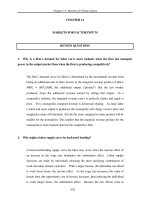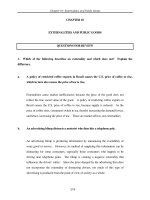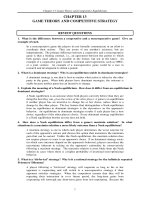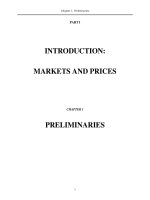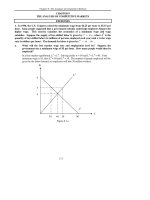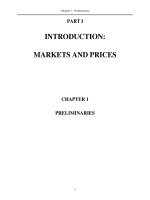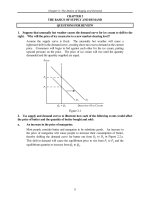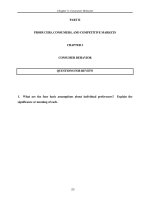Tài liệu Câu hỏi đánh giá môn Kinh tế vĩ mô bằng tiếng Anh- Chương 1 pptx
Bạn đang xem bản rút gọn của tài liệu. Xem và tải ngay bản đầy đủ của tài liệu tại đây (51.37 KB, 5 trang )
Chapter 1: Preliminaries
1
PART I
INTRODUCTION:
MARKETS AND PRICES
CHAPTER 1
PRELIMINARIES
Chapter 1: Preliminaries
2
QUESTIONS FOR REVIEW
1. It is often said that a good theory is one that can be refuted by an empirical, data-
oriented study. Explain why a theory that cannot be evaluated empirically is not a
good theory.
There are two steps to consider when evaluating a theory: first, you should
examine the reasonability of the theory’s assumptions; second, you should
test the theory’s predictions by comparing them with facts. If a theory
cannot be tested, it cannot be accepted or rejected. Therefore, it contributes
little to our understanding of reality.
2. Which of the following two statements involves positive economic analysis and
which normative? How do the two kinds of analysis differ?
a. Gasoline rationing (allocating to each individual a maximum amount of
gasoline that can be purchased each year) is a poor social policy because it
interferes with the workings of the competitive market system.
Positive economic analysis describes what is. Normative economic analysis
describes what ought to be. Statement (a) merges both types of analysis.
First, statement (a) makes a positive statement that gasoline rationing
“interferes with the workings of the competitive market system.” We know
from economic analysis that a constraint placed on supply will change the
market equilibrium. Second, statement (a) makes the normative statement
(i.e., a value judgment) that gasoline rationing is a “poor social policy.” Thus,
statement (a) makes a normative comment based on a conclusion derived
from positive economic analysis of the policy.
Chapter 1: Preliminaries
3
b. Gasoline rationing is a policy under which more people are made worse off
than are made better off.
Statement (b) is positive because it states what the effect of gasoline rationing
is without making a value judgment about the desirability of the rationing
policy.
3. Suppose the price of unleaded regular octane gasoline were 20 cents per gallon
higher in New Jersey than in Oklahoma. Do you think there would be an
opportunity for arbitrage (i.e., that firms could buy gas in Oklahoma and then sell it
at a profit in New Jersey)? Why or why not?
Oklahoma and New Jersey represent separate geographic markets for
gasoline because of high transportation costs. If transportation costs were
zero, a price increase in New Jersey would prompt arbitrageurs to buy
gasoline in Oklahoma and sell it in New Jersey. It is unlikely in this case
that the 20 cents per gallon difference in costs would be high enough to
create a profitable opportunity for arbitrage, given both transactions costs and
transportation costs.
4. In Example 1.3, what economic forces explain why the real price of eggs has fallen
while the real price of a college education has increased? How have these changes
affected consumer choices?
Chapter 1: Preliminaries
4
The price and quantity of goods (e.g., eggs) and services (e.g., a college
education) are determined by the interaction of supply and demand. The
real price of eggs fell from 1970 to 1985 because of either a reduction in
demand (consumers switched to lower-cholesterol food), a reduction in
production costs (improvements in egg production technology), or both. In
response, the price of eggs relative to other foods decreased. The real price
of a college education rose because of either an increase in demand (e.g.,
more people recognized the value of an education), an increase in the cost of
education (e.g., increase in staff salaries), or both.
5. Suppose that the Japanese yen rises against the U.S. dollar- that is, it will take
more dollars to buy any given amount of Japanese yen. Explain why this increase
simultaneously increases the real price of Japanese cars for U.S. consumers and
lowers the real price of U.S. automobiles for Japanese consumers.
As the value of the yen grows relative to the dollar, more dollars exchange
for fewer yen. Assume that the costs of production for both Japanese and
U.S. automobiles remain unchanged. Then using the new exchange rate,
the purchase of a Japanese automobile priced in yen requires more dollars.
Similarly, the purchase of a U.S. automobile priced in dollars requires fewer
yen.
6. The price of long-distance telephone service fell from 40 cents per minute in 1996
to 22 cents per minute in 1999, a 45-percent (18 cents/40 cents) decrease. The
Consumer Price Index increased by 10-percent over this period. What happened to
the real price of telephone service?
Let the CPI for 1996 equal 1 and the CPI for 1999 equal 1.1, which reflects a
10% increase in the overall price level. To find the real price of telephone
service in each period, divide the nominal price by the CPI for that year.
Chapter 1: Preliminaries
For 1996, we have 40/1 or 40 cents, and for 1999, we have 22/1.1 or 20
cents. The real price therefore fell from 40 to 20 cents, a 50% decline.
4.13− 4.07
4.07
= 0.0147, or about 1.5%.
5
